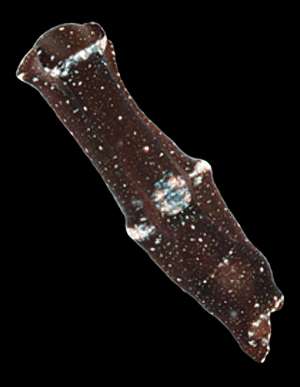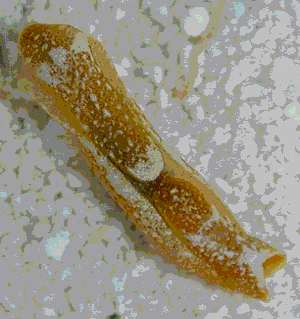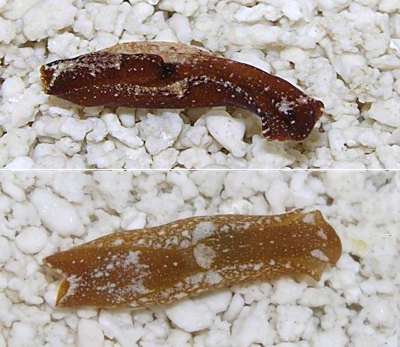

Philinopsis aeci
Ortea & Espinosa, 2001
Order: CEPHALASPIDEA
Superfamily: PHILINOIDEA
Family: Aglajidae
DISTRIBUTION
Caribbean
PHOTO
Upper: Live on Cladophora in 1m, Thurstone Bay, Abaco, Bahamas. August 18, 2002. 9mm. long alive. Photo: Colin Redfern.
Lower: In about 5 feet of water crawling on the sand during the day. Off Stocking Island, Exumas, Bahamas (Southern Bahamas) The size was approximately ½ inch long. 26 December 2003. Photo: Anne DuPont
I am pretty sure this is the animal that Colin Redfern (2001: Pl.114, figs 649) calls Philinopsis sp. A. I suspect it is closely related to the Indo-West Pacific species Aglaja? orientalis as it has a similar body shape and patterns of transverse white bands across the body.
Philinopsis aeci was recently described from the Caribbean coast of Costa Rica. In that description, the general body shape is the same as the above photos from the Bahamas, and an accompanying photograph [Ortea & Espinosa: Pl. 3, fig. A] shows traces of the white transverse bands but the background colour is a dark greenish brown. A colour painting [Ortea & Espinosa: Pl. 2, fig. C] has a much lighter background colour and yellowish tubercles, each surrounded by a bright orange red ring are very conspicuous. Similar tubercles with a white basal ring are sometimes seen in Aglaja? orientalis so I suspect their presence in the Costa Rican specimens and their absence in Bahamian animals does not necessarily mean that there are two different species. Clearly what we need is more photos to see just how much colour variation there is.
References:
• Ortea, J., Espinosa, J. (2001) A new species of Philinopsis Pease, 1860 (in Spanish). Avicennia, Moluscos del Mar caribe de Costa Rica, Suplemento 4: 41-42.
Rudman, W.B., 2004 (January 4) Philinopsis aeci Ortea & Espinosa, 2001. [In] Sea Slug Forum. Australian Museum, Sydney. Available from http://www.seaslugforum.net/find/philaeci
Related messages
Philinopsis aeci? from St. Vincent, Caribbean
January 13, 2006
From: Les Wilk

Hi Bill;
We found this crawling through grass. Is it a Philinopsis aeci?
Locality: West coast, St. Vincent, Caribbean. Depth: 30 feet. Length: 0.5 -0.75 inch. July 2005. grassy bottom. Photographer: Keri Wilk
Les Wilk
wilk@reefnet.ca
Wilk, L., 2006 (Jan 13) Philinopsis aeci? from St. Vincent, Caribbean. [Message in] Sea Slug Forum. Australian Museum, Sydney. Available from http://www.seaslugforum.net/find/15523
Dear Les,
Yes this is Philinopsis aeci. The close-up alongside shows the texture of the skin well.
Best wishes,
Bill Rudman
Colour variation in Philinopsis aeci
August 29, 2005
From: Anne DuPont


Dear Bill,
Over this past winter I was able to find and photograph several Philinopsis aeci. Here are some of the color forms. They ranged in size from 4 mm to 14 mm and were photographed in Jan, Feb and March, 2005. Location: Stocking Island, Exumas, Bahamas in depths of 6-8 feet of water.
Cordially,
Anne DuPont
Delray Beach, FL
akdupont@bellsouth.net
DuPont, A., 2005 (Aug 29) Colour variation in Philinopsis aeci . [Message in] Sea Slug Forum. Australian Museum, Sydney. Available from http://www.seaslugforum.net/find/14643
Thanks Anne,
Photos showing a range of colour variation like this are very valuable
Best wishes,
Bill Rudman
Philinopsis aeci from the Bahamas
January 8, 2004
From: Colin Redfern

Dear Bill,
I was very interested to see Anne DuPont's photos of this species, and to read your comments regarding Philinopsis aeci. I've collected two more specimens from Abaco during the past couple of years, and thought that the attached photo of a dark brown 9mm animal might be helpful. In some ways it perhaps bridges the gap between Anne's specimen and the one photographed by Ortea & Espinosa. Interestingly, there is a group of four or five reddish orange spots at the rear of the head shield, and a few less conspicuous ones elsewhere. Also attached is a photo of a much smaller, more yellowish animal. If I have correctly identified this as a juvenile of the same species, it shows that the white transverse bands may sometimes consist of little more than a few white spots. This specimen also has a couple of reddish orange spots towards the rear of the head shield.
Upper Photo: 9mm. Live on Cladophora in 1m, Thurstone Bay, Abaco, Bahamas. August 18, 2002.
Lower Photo: 2.75mm. Live on Sargassum attached to the substrate in 0.6m. Guana Cay, Abaco, Bahamas. August 12, 2003.
Best wishes,
Colin
bahamianseashells@att.net
![]()


Thanks Colin,
In my comments on Anne Dupont's message I said what we needed were more photos and in two days we have them! Thanks very much. The reddish tubercles in the larger of your two animals certainly link the Bahamian animals with the original specimens from Costa Rica. Interestingly, as I said before, similar tubercles are associated with the whitish transverse bands in the Indo-West Pacific species Aglaja? orientalis.
Both these animals are dark brown, like Ortea & Espinosa's original photo, while the photos in your book, although with prominent white transverse bands, are much lighter, as in Anne Dupont's animals. These new photos of yours are indeed a valuable addition, clearly linking Anne's animals and those of Ortea & Espinosa.
Best wishes
Bill Rudman
Philinopsis aeci from the Bahamas
January 6, 2004
From: Anne DuPont

Dear Bill,
Happy New Year. Hope that you and your family had a good holiday.
I am back in the Bahamas for the winter and finding the head shield slugs again. And I have found one that I cannot identify. Can you identify it for me, please?
It was found on December 26,2003 about 1 PM. It was in about 5 feet of water crawling on the sand during the day off Stocking Island, Exumas, Bahamas (Southern Bahamas) The size was approximately ½ inch long. This was the only one I saw that day. It was found in an area that I also found: Philinopsis depicta, Aglaja felis, Chelidonura hirundinina and Chelidonura berolina.
Thank you for your time.
Cordially,
Anne DuPont
Delray Beach, Fl., USA
akdupont@bellsouth.net



Dear Anne,
I am pretty sure this is the animal that Colin Redfern (2001: Pl.114, figs 649) calls Philinopsis sp. A. I suspect it is closely related to the Indo-West Pacific species Aglaja? orientalis as it has a similar body shape and patterns of transverse white bands across the body.
It sems that this species has been recently described from the Caribbean coast of Costa Rica as Philinopsis aeci. In that description, the general body shape is the same and an acoompanying photograph [Pl. 3, fig. A] shows traces of the white transverse bands but the background colour is a dark yellowish brown. A colour painting [Pl. 2, fig. C] has a much lighter backfround colour and yellowish tubercles, each surrounded by a bright orange red ring are very conspicuous. Similar tubercles with a white basal ring are sometimes seen in Aglaja? orientalis so I suspect their presence in the Costa Rican specimens and their absence in Bahamian animals does not necessarily mean that there are two different species. Clearly what we need is more photos to see just how much colour variation there is.
• Ortea, J., Espinosa, J. (2001) A new species of Philinopsis Pease, 1860 (in Spanish). Avicennia, Moluscos del Mar caribe de Costa Rica, Suplemento 4: 41-42.
Thanks for starting the year with some interesting finds
Best wishes
Bill Rudman
